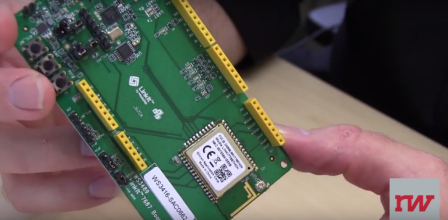It’s not hard to make IoT hardware easy
It’s not hard to make IoT hardware easy

Marc Naddell is VP of Ecosystems at MediaTek, one of the leading chipset manufacturers behind the IoT ecosystem. He came to the ReadWrite office to sit with Christopher Caen and talk about how one of the leading chipset providers in the industry managed to get ahead of the hardware curve in developing for IoT.
“We looked at the potential for IoT and realized it’s either going to be huge, or it’s going to be really huge,” said Naddell. The MediaTek team, based in San Jose, also realized they were uniquely positioned to lead this new market as the major chipset provider for consumer electronics and fabless semiconductors. Last year, MediaTek shipped more than 1.5 billion chipsets overall for various devices, including smartphones and tablets. When they evaluated the opportunities for companies to drive new products and revenue within IoT, they saw the alignment with MediaTek’s capabilities and began to develop new chipsets.
To start, they launched MediaTek Labs and their first MediaTek LinkIt™ development platform (LinkIt ONE) in September 2014 and worked closely with IoT developers to understand the next wave of products. Leveraging this knowledge, they were able to design the next wave of developer offerings and released Linkit Connect 7681, adding to its new portfolio of Hardware Development Kits for IoT developers. It satisfied developer demand for simple connectivity to create IoT products like smart door locks, and light bulbs. For more advanced smart home and office solutions, MediaTek followed with a more feature-rich development platform, the LinkIt Smart 7688.
In Q2 this year, they announced the new MediaTek LinkIt™ Development Platform for RTOS. This platform is the first from MediaTek delivering a common toolset and application programming interface (API) for multiple chipsets, including MT7687 and MT2523. It offers developers the ability to create a range of IoT devices using one common SDK with support for professional-grade IDEs (Keil µVision and IAR Embedded Workbench) as well as use of command-line tools.
New hardware kit rolled out this summer
The first hardware development kit (HDK) for the new platform was made available this summer, the LinkIt 7687 HDK, developed by Silicon Application Corp. (SAC). The HDK is based on the MediaTek MT7687F Wi-Fi system on a chip (SOC), and supports developers looking to create advanced connected appliances, home and office automation devices, smart gadgets and other IoT innovations with secure Wi-Fi. The second development kit for the platform, LinkIt 2523 HDK by SAC, is based on the MT2523G chip which enables you to create Bluetooth-enabled wearables with small footprint, fast and accurate positioning at low power consumption, and high-quality audio playback.
The initiative to work closely IoT developers has proved successful with a number of developers using MediaTek solutions to move from prototypes to successful commercial products. Now, many enterprises are replicating the MediaTek method of running a similar “labs” program to better learn from developers. But as MediaTek managed to get ahead of the curve, they appear to have the advantage when it comes to connecting their customers with supply chain partners to manufacture and drive success for their IoT devices.
This article was produced in partnership with MediaTek.
The post It’s not hard to make IoT hardware easy appeared first on ReadWrite.
(8)


